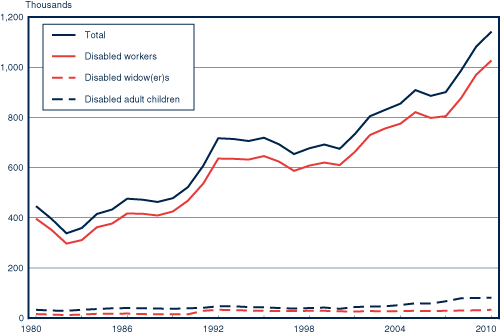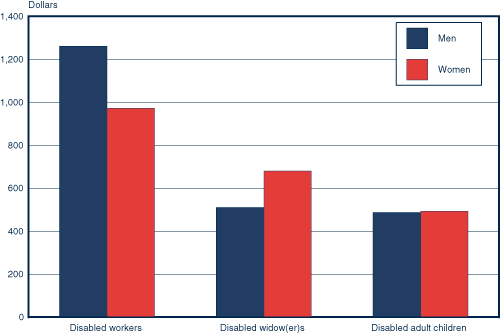Annual Statistical Report on the Social Security Disability Insurance Program, 2010
Benefits Awarded, Withheld, and Terminated
The total number of awards decreased from 1980 through 1982, started to rise in 1983, and began to increase more rapidly in 1990. Awards for disabled-worker benefits have been most pronounced and drive the overall pattern shown in the total line. They increased from a low of 297,131 in 1982 to 636,637 in 1992, were relatively flat from 1992 through 2000, and started to increase again in 2001. There were 1,026,988 worker awards in 2010. Other awards have risen at a much slower rate. Awards to disabled adult children have gradually increased from 33,470 in 1980 to 81,681 in 2010. Awards to disabled widow(er)s have risen from just over 16,000 in 1980 to 33,259 in 2010.

| Year | Total | Disabled workers |
Disabled widow(er)s |
Disabled adult children |
|---|---|---|---|---|
| 1980 | 446.08 | 396.56 | 16.05 | 33.47 |
| 1981 | 396.55 | 351.85 | 14.15 | 30.55 |
| 1982 | 338.28 | 297.13 | 12.44 | 28.71 |
| 1983 | 359.60 | 311.55 | 14.41 | 33.64 |
| 1984 | 415.59 | 362.00 | 17.17 | 36.43 |
| 1985 | 433.54 | 377.37 | 17.09 | 39.08 |
| 1986 | 475.81 | 416.87 | 18.42 | 40.53 |
| 1987 | 471.91 | 415.85 | 16.40 | 39.67 |
| 1988 | 463.52 | 409.49 | 15.33 | 38.70 |
| 1989 | 477.75 | 425.58 | 15.17 | 37.00 |
| 1990 | 522.17 | 467.98 | 15.42 | 38.77 |
| 1991 | 607.11 | 536.43 | 29.59 | 41.09 |
| 1992 | 716.88 | 636.64 | 33.24 | 47.01 |
| 1993 | 714.32 | 635.24 | 31.84 | 47.25 |
| 1994 | 706.26 | 631.87 | 29.90 | 44.48 |
| 1995 | 718.70 | 645.83 | 29.60 | 43.28 |
| 1996 | 693.53 | 624.34 | 28.61 | 40.58 |
| 1997 | 654.66 | 587.42 | 28.55 | 38.70 |
| 1998 | 677.47 | 608.13 | 29.40 | 39.94 |
| 1989 | 691.89 | 620.49 | 29.65 | 41.75 |
| 2000 | 675.60 | 610.70 | 27.60 | 37.30 |
| 2001 | 732.70 | 661.90 | 26.50 | 44.30 |
| 2002 | 805.31 | 730.38 | 28.34 | 46.59 |
| 2003 | 829.83 | 755.71 | 27.32 | 46.80 |
| 2004 | 854.87 | 775.24 | 27.74 | 51.88 |
| 2005 | 909.68 | 821.21 | 29.58 | 58.90 |
| 2006 | 885.88 | 798.68 | 28.68 | 58.52 |
| 2007 | 901.11 | 804.79 | 28.81 | 67.52 |
| 2008 | 987.53 | 877.23 | 30.61 | 79.69 |
| 2009 | 1,081.98 | 970.70 | 31.52 | 79.77 |
| 2010 | 1,141.93 | 1,026.99 | 33.26 | 81.68 |
The average monthly benefit awarded to disabled workers is higher than that awarded to disabled widow(er)s or disabled adult children. The reason for the difference is that disabled workers receive 100 percent of the primary insurance amount, compared with 71.5 percent for disabled widow(er)s and 50 percent for disabled adult children (if the worker is disabled or retired) or 75 percent (if the worker is deceased).
Because men have traditionally had higher earnings than women, their monthly benefit is higher. This is most obvious in the disabled-worker group. Benefits for disabled widow(er)s and disabled adult children are dependents' benefits, so their monthly benefit is a function of the worker's earnings. Therefore, a disabled widow's average benefit tends to be higher than that of a disabled widower because a male worker's earnings are higher than a female worker's. Benefit amounts are about the same for men and women in the disabled adult children group.

| Beneficiary | Men | Women |
|---|---|---|
| Disabled workers | 1,261.9 | 971.8 |
| Disabled widow(er)s | 510.1 | 680.9 |
| Disabled adult children | 487.0 | 492.8 |
In 2010, 1,026,988 disabled workers were awarded benefits. Among those awardees, the most common impairment was diseases of the musculoskeletal system and connective tissue (32.5 percent), followed by mental disorders (21.4 percent), circulatory problems (10.2 percent), neoplasms (9.0 percent), and diseases of the nervous system and sense organs (8.2 percent). The remaining 18.7 percent of awardees had other impairments.

| Diagnostic group | Percent |
|---|---|
| Mood disorders | 11.2 |
| Organic mental disorders | 2.9 |
| Schizophrenic and other psychotic disorders | 2.1 |
| Other | 3.0 |
| Autistic disorders | 0.2 |
| Developmental disorders | 0.1 |
| Childhood and adolescent disorders not elsewhere classified | 0.1 |
| Intellectual disability | 1.8 |